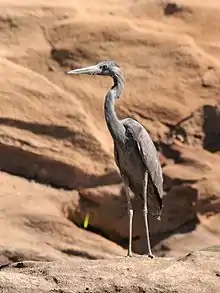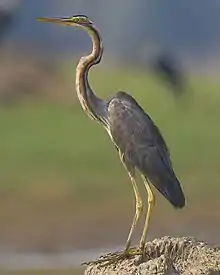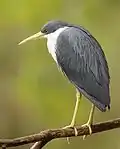Ardea (genus)
Ardea is a genus of herons. The genus name comes from Latin ardea "heron".[1] Linnaeus named this genus as the great herons, referring to the generally large size of these birds, typically 80–100 cm or more in length.
_with_Great_Egret_(Casmerodius_albus)_W_IMG_9999.jpg.webp)
| Ardea Temporal range: Middle Miocene to present | |
|---|---|
 | |
| Great blue heron (A. herodias) | |
| Scientific classification | |
| Kingdom: | Animalia |
| Phylum: | Chordata |
| Class: | Aves |
| Order: | Pelecaniformes |
| Family: | Ardeidae |
| Genus: | Ardea Linnaeus, 1758 |
| Species | |
|
19, see text | |
| Synonyms | |
|
Casmerodius | |
These large herons are associated with wetlands where they prey on fish, frogs, and other aquatic species.
Most members of this almost worldwide group breed colonially in trees, building large stick nests. Northern species such as great blue, grey, and purple herons may migrate south in winter, although the first two do so only from areas where the waters freeze.
These are powerful birds with large spear-like bills, long necks and long legs, which hunt by waiting motionless or stalking their prey in shallow water before seizing it with a sudden lunge. They have a slow steady flight, with the neck retracted as is characteristic of herons and bitterns; this distinguishes them from storks, cranes, flamingos, and spoonbills, which extend their necks.
Taxonomy
Some members of Ardea are clearly very closely related, such as the grey, great blue, and cocoi herons, which form a superspecies. However, the great egret, in particular, has been placed in other genera by various authors as Egretta alba and Casmerodius albus. Nevertheless, this species closely resembles the large Ardea herons in everything but color, whereas it shows fewer similarities to the smaller white egrets.
Species
| Image | Scientific name | Common Name | Distribution |
|---|---|---|---|
 | Ardea herodias | Great blue heron | North America, as far north as Alaska and the southern Canadian provinces in the summer. In winter, the range extends south through Florida, Mexico, and the Caribbean to South America |
 | Ardea cinerea | Grey heron | northern Spain, France, central Italy, the Balkans, the Caucasus, Iraq, Iran, India, and Myanmar (Burma). Africa south of the Sahara Desert, the Canary Islands, Morocco, Algeria, Tunisia, and many of the Mediterranean Islands |
.jpg.webp) | Ardea goliath | Goliath heron | sub-Saharan Africa |
 | Ardea cocoi | Cocoi heron | South America |
 | Ardea pacifica | White-necked heron or Pacific heron | Australian continent |
.jpg.webp) | Ardea melanocephala | Black-headed heron | sub-Saharan Africa and Madagascar. |
 | Ardea humbloti | Humblot's heron | Madagascar |
.jpg.webp) | Ardea insignis | White-bellied heron | eastern Himalayas of India and Myanmar. |
 | Ardea sumatrana | Great-billed heron | Southern Asia and Australasia including Australia, India, Indonesia, Malaysia, and the Philippines. |
 | Ardea purpurea | Purple heron | Africa, central and southern Europe, and southern and eastern Asia |
 | Ardea alba | Great egret or great white egret | Asia, Africa, the Americas, and southern Europe. |
_in_Hyderabad_W_IMG_8406.jpg.webp) | Ardea intermedia | Intermediate egret | Southeast Asia and Australia. |
 | Ardea picata | Pied heron | northern Australia |
A number of Ardea species are only known from subfossil or fossil bones. Their placement in Ardea versus Egretta may be provisional:
- Bennu heron, Ardea bennuides (prehistoric)
- Ardea sp. (Middle Miocene of Observation Quarry, US) (fossil)
- Ardea sp. (Late Miocene of Love Bone Bed, US) (fossil)
- Ardea polkensis (Early Pliocene of Bone Valley, US) (fossil)
- Ardea sp. (Early Pleistocene of Macasphalt Shell Pit, US) (fossil)
- Ardea howardae (fossil)
The remains described as Ardea perplexa are nowadays usually believed to be from an ibis of the genus Geronticus or closely related genera. "Ardea formosa" (a nomen nudum) is now Proardeola, "Ardea" brunhuberi and "A." similis refer to a misidentified cormorant (Phalacrocorax intermedius) and partridge (Miogallus altus), respectively. "Ardea" lignitum – a fossil of quite recent age as it seems – is some large owl, perhaps even a Eurasian eagle-owl (Bubo bubo).
References
- Jobling, James A (2010). The Helm Dictionary of Scientific Bird Names. London: Christopher Helm. p. 54. ISBN 978-1-4081-2501-4.
| Wikimedia Commons has media related to Ardea. |